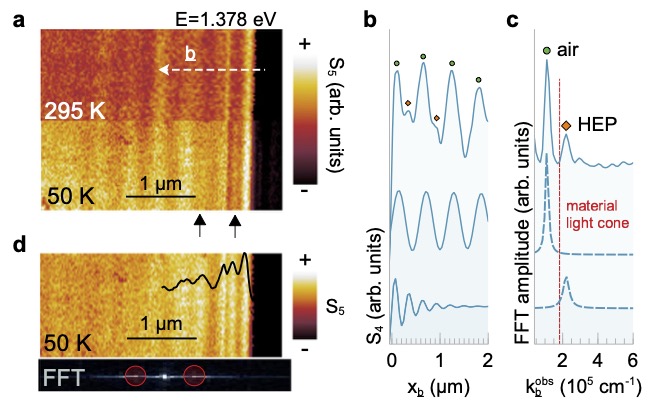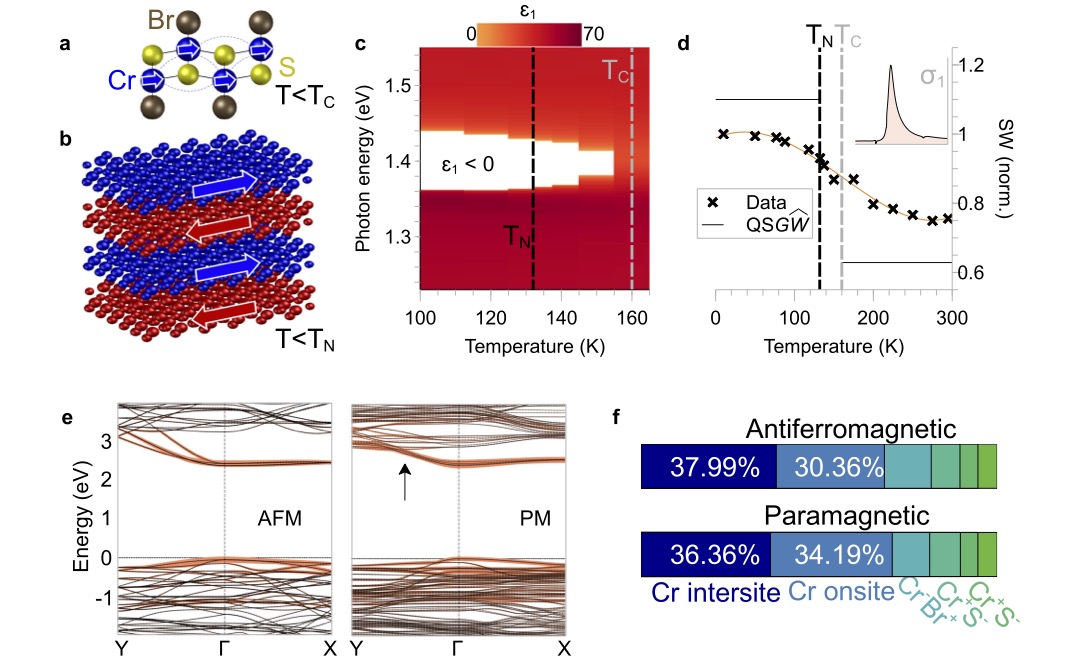Examples
Hyperbolic Exciton Polaritons
This post concerns the first observation of hyperbolic exciton polaritons (HEPs) by the Basov group at Columbia University. It is one of a continuing series probing some remarkable properties of the 2D van der Waals (vdW) magnet, CrSBr.
Systems become hyperbolic when, over some range of frequency, the sign of the dielectric function along one crystal axes become different from another. In this unique situation remarkable properties can emerge. For example they can provide a path to practical realization of an “invisibility cloak:” the hyperbolicity can cause light to bend around an object and render it invisible. A material must be strongly anisotropic for this to occur, and usually the hyperbolicity occurs over a relative small frequency window. CrSBr is highly anisotropic, and it becomes hyperbolic in the near infrared at low temperature (see Fig. 2c).
Independently of this, polaritons can arise when coupling between confined light and matter becomes strong. Usually the light-matter interaction is weak, and the presence of light doesn’t change the quantum states in the material in any essential way, but acts merely acts to scatter electrons from one state to another. When interactions are strong, the light and matter can become entangled and form a new coherent quantum state consisting of both. These states—polaritons—have long been established, but when polaritons occur in hyperbolic systems, exotic new modes called hyperbolic exciton polaritons (HEPs) have been predicted.
Microcavities—where reflective mirrors on either side of a semiconducting well form a waveguide for light. In semiconductors, they are effective at trapping and stabilizing light to achieve exciton polaritons. Slabs of vdW semiconductors inside waveguides allow excitons in the semiconductor to strongly interact with light. Such geometry lends itself to nanoscale-/wavelength-level imaging, but that process is challenging. Near-infrared light has a short wavelength and alignment is challenging. Further, near-infrared light has a shorter wavelength and alignment is more challenging relative to mid-infrared light. To achieve this strong coupling, cryogenic temperatures are needed in most vdW materials. Alignment at low temperature in an ultra-high vacuum presents even more difficulties. These experimental conditions are necessary to observe HEPs, however, since CrSBr only becomes hyperbolic at low temperature and in the near infrared. The Basov group developed a cryogenic near-infrared, near-field microscope to enable HEP imaging and applied it to the vdW magnetic semiconductor, CrSBr. In part because of its magnetic properties, CrSBr is unique because excitons exhibit both strong oscillator strength—which is the mechanism that enables electrons to be absorbed and emitted, with small scattering rates which limit the lifetime. The signature accomplishment of this recent study published in Nature Communications, was the first observation of HEPs, observed at low temperature in CrSBr. The NREL team provided a theoretical for this study, using special features of Questaaal to explain why the exciton oscillator strength depends on the degree of disorder in the magnetic subsystem.

The experimental team verified through their cryogenic near-infrared, near-field microscope, that strong coupling between excitons and polaritons occurs directionally in CrSBr at room temperature (Fig. 1). At the cryogenic temperature, a hyperbolic band appears, causing waveguide dispersions to split. Hyperbolicity does not occur at room temperature, however, confirming the preference for low temperature state. Energy-dependent subdiffractional fringes—where waves spread around and away from obstacles—connected to HEPs appear in low temperature, as well, identified by their subdiffractional periodicity (i.e., they showcase shorter wavelengths than the light wavelength). Temperature, thickness, and the energy dependence of subdiffractional fringes revealed expected HEP properties in the imaging experiment. Strong coupling occurred in CrSBr and researchers proposed that magneto-electronic coupling is partly responsible for hyperbolicity in CrSBr.
Many of the fundamental properties of HEPs depend on how bright these excitons are. The spin chains—types of models originally formulated to depict magnetic systems—in antiferromagnets order below a critical temperature called the Néel temperature, named after the French physicist Louis Néel. For popular antiferromagnets like NiO, CoO the Néel temperatures are 525 K and 293 K respectively. The spin chains in CrSBr order below ~140 K. It is not a common practice in the community to build and employ an efficient parameter free theory that can describe the excitons of a magnet both above and below the Néel temperature. Questaal’s robust theoretical framework for the electronic structure and response functions in magnets both, in both their ordered and disordered variants offers a step change in exploring role of order-disorder transition on magnetic excitons. The physical picture emerging from the calculation shows that the exciton’s brightness is determined by how easily electrons and holes can hop through the ferromagnetic Chromium chains. When the spins disorder above the Néel temperature, electrons and holes don’t find it easy to hop through the spin chains and hence their wavefunctions get localized and the excitons become darker. This principle, as it becomes established, should be valid for a large class of vdW magnets and is not confined to CrSBr only.

This work shows that HEPs can confine light in semiconductors to spatial dimensions below conventional diffraction limits, allowing us to miniaturize optoelectronic excitonic devices beyond the limits that light normally imposes on us. HEPs observed in CrSBr are still far too lossy to be practical. The challenge for researchers now is to figure out how to extend HEP lifetimes. Incorporating CrSBr into a resonant cavity is a promising route, or we may search for materials with even stronger exciton resonances.
PAPERS · SELF-CONSISTENCY · 2D MAGNETS
